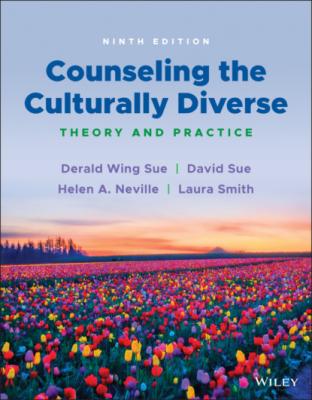ТОП просматриваемых книг сайта:
Counseling the Culturally Diverse. Laura Smith L.
Читать онлайн.Название Counseling the Culturally Diverse
Год выпуска 0
isbn 9781119861911
Автор произведения Laura Smith L.
Жанр Психотерапия и консультирование
Издательство John Wiley & Sons Limited
Overt sexism
REFERENCES
1 American Psychological Association. (2016). Stress in America: The impact of discrimination. Washington, DC: American Psychological Association.
2 Asian American Psychological Association . (2021, March 18). Written testimony from the Asian American Psychological Association. Before the United States House of Representative. Hearing on Discrimination and Violence Against Asian Americans.
3 Auguste, E. E., Cruise, K. R., & Jimenez, M. C. (2021). The effects of microaggressions on depression in young adults of color: Investigating the impact of traumatic event exposures and trauma reaction. Journal of Traumatic Stress, 0, 1–10.
4 Becker, J. C., & Swim, J. K. (2012). Reducing endorsement of benevolent and modern sexist beliefs: Differential effects of addressing harm versus pervasiveness of benevolent sexism. Social Psychology, 43, 127–137.
5 Bell, L. A. (2003). Telling tales: What stories can teach us about racism. Race, Ethnicity and Education. 6, 3–28.
6 Blume, A. W., Lovato, L. V., Thyken, B. N., & Denny, N. (2012). The relationship of microaggressions with alcohol use and anxiety among ethnic minority college students in a historically White institution. Cultural Diversity and Ethnic Minority Psychology, 18, 45–54.
7 Bostwick, W., & Hequembourg, A. (2014). “Just a little hint”: Bisexual‐specific microaggressions and their connection to epistemic injustices. Culture, Health and Sexuality, 16, 488–503.
8 Bryant‐Davis, T. (2018). Microaggressions: Considering the framework of psychological trauma. In G. C. Torino, D. P. Rivera, C. M. Capodilupo, K. L. Nadal, & D. W. Sue (Eds.), Microaggression theory: Influence and implication. Hoboken, NJ: Wiley.
9 Burn, S. M., Kadlec, K., & Rexer, B. S. (2005). Effects of subtle heterosexism on gays, lesbians, and bisexuals. Journal of Homosexuality, 49, 23–38.
10 Burns, C., & Krehely, J. (2011). Gay and transgender people face high rates of workplace discrimination and harassment. Retrieved from https://www.americanprogress.org/issues/lgbt/news/2011/06/02/9872/gay‐and‐transgender‐people‐face‐high‐rates‐of‐workplace‐discrimination‐and‐harassment/
11 Calogero, R. M., & Tylka, T. L. (2014). Sanctioning resistance to sexual objectification: An integrative system justification perspective. Journal of Social Issues, 70, 763–778.
12 Cundiff, J. L., Zawadzki, M. J., Danube, C. L., & Shields, S. A. (2014). Using experiential learning to increase the recognition of everyday sexism as harmful: The WAGES intervention. Journal of Social Issues, 70, 703–721.
13 Dovidio, J. F., & Gaertner, S. L. (2000). Aversive racism and selective decisions: 1989–1999. Psychological Science, 11, 315–319.
14 Dovidio, J. F., Gaertner, S. L., & Pearson, A. R. (2017). Aversive racism and contemporary bias. In F. K. Barlow, & C. G. Sibley (Eds.), The Cambridge handbook of the psychology of prejudice (pp. 267–294). Cambridge: Cambridge University Press.
15 Gaertner, S. L., & Dovidio, J. F. (2006). Understanding and addressing contemporary racism: From aversive racism to the common ingroup. Journal of Social Issues, 61, 615–639.
16 Gallup Poll . (2020, July 15). Black adults disproportionately experience microaggressions.
17 Harper, S. R. (2013). Am I my brother's teacher? Black undergraduates, racial socialization, and peer pedagogies in predominately white postsecondary contexts. Review of Research in Education, 37, 183–211.
18 Hill, D. B., & Willoughby, B. L. B. (2005). The development and validation of the genderism and transphobia scale. Sex Roles, 53, 531–544.
19 Hook, J. N., Farrell, J. E., Davis, D. E., DeBlaere, C., Van Tongeren, D. R., & Utsey, S. O. (2016). Cultural humility and racial microaggressions in counseling. Journal of Counseling Psychology, 63(3), 269–277.
20 Huber, L. P., & Cueva, B. M. (2012). Chicana/Latina testimonials on effects and responses to microaggressions. Equity & Excellence in Education, 45(3), 392–410.
21 Huber, L. P., & Solorzano, D. G. (2015). Racial microaggressions as a tool for critical race research. Race, Ethnicity, and Education, 18(3), 297–320.
22 Jones, M. L., & Galliher, R. V. (2014). Daily microaggressions and ethnic identification among Native American young adults. Cultural Diversity and Ethnic Minority Psychology, 21, 1–9.
23 Keller, R. M., & Galgay, C. E. (2010). Microaggressive experience of people with disabilities. In D. W. Sue (Ed.), Microaggressions and marginality (pp. 241–267). Hoboken, NJ: Wiley.
24 Martin, J. L. (2019). Factors contributing to microaggressions, racial battle fatigue, stereotype threat, and imposter phenomenon for nonhegemonic students: Implications for urban education. In G. C. Torino, D. P. Rivera, C. M. Capodilupo, K. L. Nadal, & D. W. Sue (Eds.). Microaggression Theory: Influence and implications (pp. 309–328). Hoboken, N. J.: John Wiley & Sons.
25 Marzullo, M. A., & Libman, A. J. (2009). Research overview: Hate crimes and violence against lesbian, gay, bisexual and transgender people. Report for the Human Rights Campaign Foundation. Retrieved from http://www.hrc.org/resources/entry/hate‐crimes‐and‐violence‐against‐lgbt‐people
26 Morrison, M. A., & Morrison, T. G. (2002). Development and validation of a scale measuring prejudice toward gay men and lesbian women. Journal of Homosexuality, 43, 15–37.
27 Muran, J. C., Eubanks, C. F., & Samstag, L. W. (2020). One more time with less jargon: An introduction to “Rupture Repair in Practice.” Journal of Clinical Psychology. 2021, 1–8.
28 Nadal, K. L. (2013). That's so gay! Microaggressions and the lesbian, gay, bisexual, and transgender community. Washington, DC: American Psychological Association.
29 Nadal, K. L., Griffin, K. E., Wong, Y., Davidoff, K. C., & Davis, L. S. (2017). The

